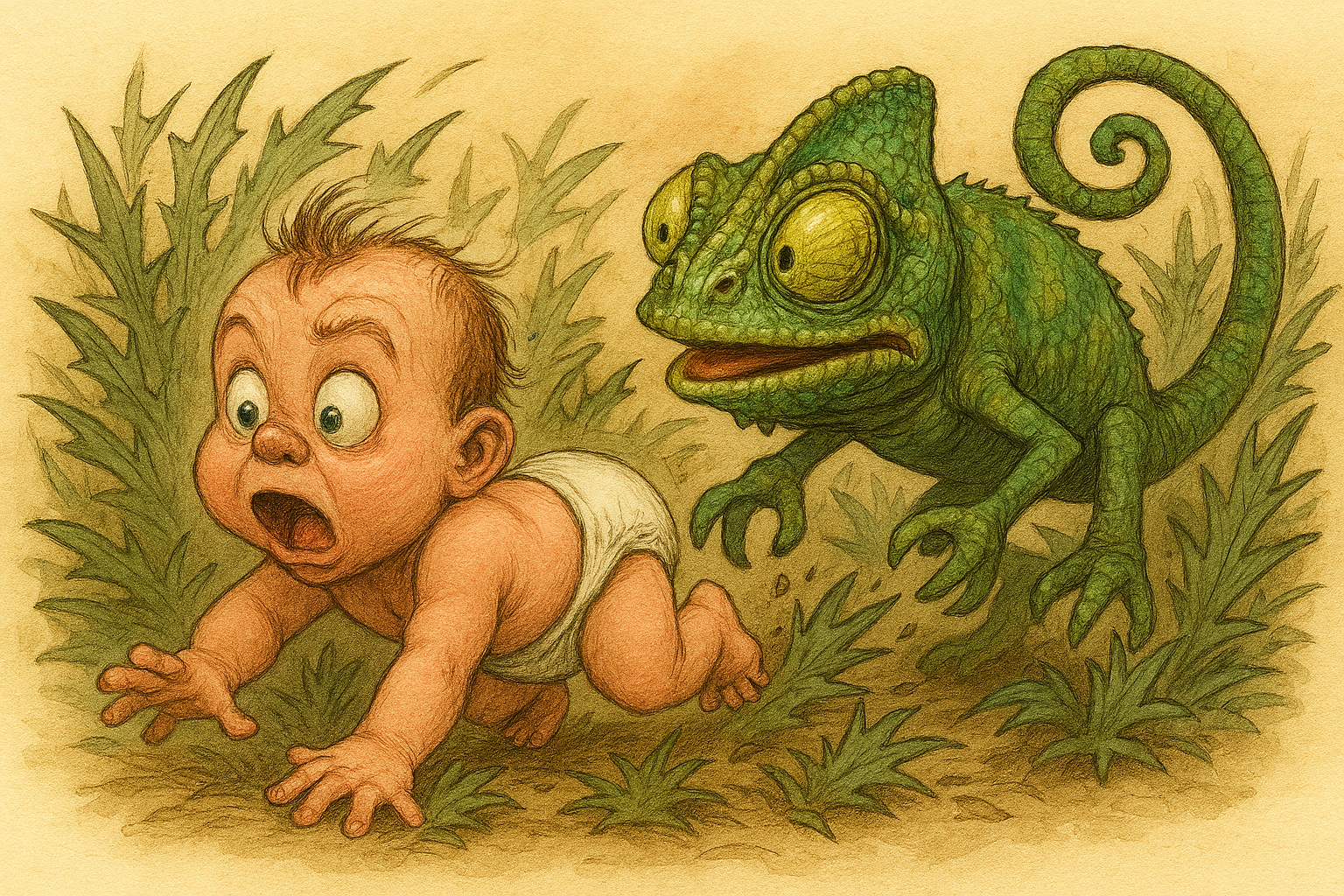Chameleon Weight Woes: The Case of the 402-Pound Reptile Who Wanted to Be Human!
A recent online debate in one US-based chameleon community (identity unrevealed for colleagial and ethical reasons) spiraled into what can only be described as reptilian math madness. The question: if a chameleon were scaled up to human height, how much would it weigh?

One eager participant crunched the numbers using a panther chameleon's supposed stats—17.5 cm in length and 200 grams in weight. Scaling that up to 170 cm, they multiplied the weight by 9.71 and proudly declared the result: 4.27 pounds. Cute, but completely off.
Why? Because panther chameleons don't max out at 17.5 cm. They typically reach around 40 cm, still weighing about 200 grams. And more importantly, weight doesn't scale linearly with length—it scales with volume. That means you cube the scaling factor. So, 9.71 cubed equals 915.
This was a creative approach of another expert, who multiplied that 915 by 200 grams and you get a theoretical weight of 183 kilograms, or 402 pounds. That's not a chameleon—it's a small horse. Right approach, but not corrected primary assumptions.
Still, even that's a stretch. Using correct proportions and scaling from 40 cm to 170 cm, the more realistic weight lands around 15.4 kilograms, or 34 pounds. That's hefty, but not monstrous.
Now, before you start imagining a chameleon in jeans and sneakers, remember: comparing a lizard to a human isn't straightforward. Their body shapes are wildly different. But interestingly, both species share a similar structural quirk—chameleons have tails that make up about 50 percent of their total length, and humans (especially runway models) often have legs that account for roughly half their height. So, while imperfect, the comparison isn't entirely absurd.
In the end, the real lesson is this: scaling animals is tricky, volume matters, and if your math says a chameleon weighs 402 pounds, it might be time to put the calculator down and go outside.
Epilogue 1: Honey, I Shrunk the Homo Sapiens
We've scaled the chameleon up to human height and discovered it wouldn't weigh 4 pounds or 402 pounds, but a surprisingly reasonable 34 pounds. Now let's flip the script: what if a human wanted to be the same size as a chameleon?

Let's do the math properly this time. Average human height: 170 cm Average panther chameleon length: 40 cm Scale factor: 40 ÷ 170 ≈ 0.235 Now cube that to account for volume: 0.235³ ≈ 0.013
So if an average adult human weighs 70 kg: 70 × 0.013 ≈ 0.91 kg
That's 910 grams—about the weight of a family-sized tub of yogurt. Imagine a tiny human that size: dodging raindrops like water balloons, using thimbles as helmets, and getting chased by house cats like it's a gladiator arena. Downsizing might sound fun until your toothbrush becomes a tree trunk.
But here's the real twist: chameleons are born as perfect miniatures of their adult selves. Their proportions stay consistent as they grow—just add horns, crests, and a bit of flair. Humans, on the other hand, are a developmental rollercoaster. Babies are born with disproportionately large heads, short limbs, and torsos that scream "I haven't figured out gravity yet."
As we grow, our legs stretch out, our heads shrink proportionally, and we morph into the upright beings we know and love. This transformation is called allometric growth—a scientific term for when different body parts grow at different rates. It's why toddlers look like bobbleheads and adults don't (well, most of us).
And just to put things in perspective: the average human at birth weighs around 3.5 kilograms at around 50cm —already nearly four times heavier than our hypothetical downsized adult. Why the difference? Because baby humans are built for transformation, while baby chameleons are basically ready to file taxes from day one.
If humans were born like chameleons—fully proportioned and ready to climb trees—we'd probably skip kindergarten and go straight to existential crises.
Epilogue 2: Honey, This Is Reality

Forget the math games: this is the real deal. The average adult human stands at 170 cm and weighs around 70 kilograms. Now meet the heavyweight champion of the chameleon world: Calumma parsonii, Parson's chameleon in full glory.
The biggest individual I've ever seen stretched a jaw-dropping 78 centimeters and tipped the scales at 1,200 grams. That's not a lizard, it's a slow-moving, leaf-colored legend. If it wore a crown, it wouldn't be for camouflage, it'd be for sheer presence.
So when you picture a human next to this emerald titan, the proportions aren't fantasy, they're fact. The image shows it clearly: humans are vertical thinkers, chameleons are horizontal marvels. One builds empires, the other vanishes into foliage.
Scaling animals is fun. But sometimes, reality outpaces imagination. And Calumma parsonii? It's not just the biggest chameleon—it's a reminder that nature doesn't need exaggeration. It already nailed the drama.